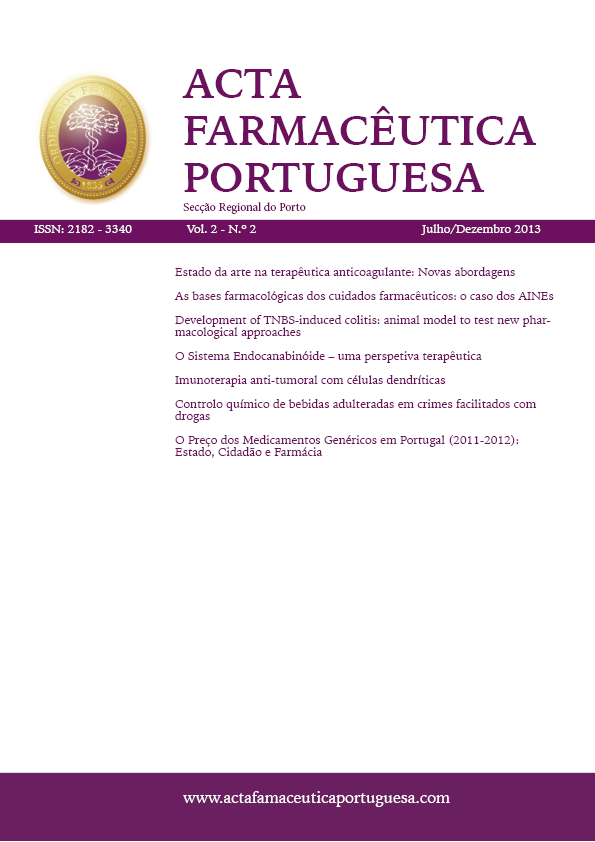Development of TNBS-induced colitis: animal model to test new pharmacological approaches
Abstract
IBD is a gastro-intestinal disorder marked with chronic inflammation of intestinal epithelium, dam- aging mucosal tissue and manifests into several intestinal and extra-intestinal symptoms. Currently used medical therapy is able to induce and maintain the patient in remission, however no modifies or reverses the underlying pathogenic mechanism. The research of other medical approaches is crucial to the treatment of IBD and, for this, it ́s important to use animal models to mimic the characteristics of disease in real life. The aim of the study is to develop an animal model of TNBS-induced colitis to test new pharmacological approaches. TNBS was instilled intracolonic single dose as described by Morris et al. It was administered 2,5% TNBS in 50% ethanol through a catheter carefully inserted into the colon. Mice were kept in a Tredelenburg position to avoid reflux. On day 4 and 7, the animals were sacrificed by cervical dislocation. The induction was confirmed based on clinical symptoms/signs, ALP determination and histopathological analysis. At day 4, TNBS group presented a decreased body weight and an alteration of intestinal motility characterized by diarrhea, severe edema of the anus and moderate morbidity, while in the two control groups weren’t identified any alteration on the clinical symptoms/signs with an increase of the body weight. TNBS group presented the highest concentrations of ALP comparing with control groups. The histopathology analysis revealed severe necrosis of the mucosa with widespread necrosis of the intestinal glands. Severe hemorrhagic and purulent exsudates were observed in the submucosa, muscular and serosa. TNBS group presented clinical symptoms/ signs and histopathological features compatible with a correct induction of UC. The peak of manifestations became maximal at day 4 after induction. This study allows concluding that it’s possible to develop a TNBS- induced colitis 4 days after instillation.
References
Pithadia A, Jain S. Treatment of inflammatory bowel disease (IBD). Pharmacological Reports. 2011; 63:629-42
Hanauer S. Inflammatory bowel disease: epidemi- ology, pathogenesis, and therapeutic opportuni- ties. Inflamm Bowel Dis. 2006; 12(1):3–9
Spiegel B. The burden of IBS: looking at metrics. Curr Gastroenterol Rep. 2009; 11:265–9
Wirtz S, Neurath M. Mouse models of inflamma- tory bowel disease. Adv Drug Del Rev. 2007; 59:1073–83
Mayer L. Evolving paradigms in the pathogenesis of IBD. J Gastroenterol. 2010; 45:9–16
Strober W. Fuss I, Mannon P. The fundamental ba- sis of inflammatory bowel disease. J Clin Invest. 2007; 117:514–21 in doi:10.1172/JCI30587
Engel M, Neurath M. New pathophysiological in- sights and modern treatment of IBD. J Gastroen- terol. 2010; 45:571-83
Qin H, Wu J, Tong X, Sung J, Xu H, Bian Z. System- atic review of animal models of post-infectious/ post-inflammatory irritable bowel syndrome. J Gastroenterol. 2011; 46:164–74
Szczepanik M, Góralska M, Marciñska K, Wiacek M, Strzepa A, Dorozynska I, Szczepanik M. Epicutaneous immunization with protein an- tigen TNP-Ig alleviates TNBS-induced colitis in mice. Pharmacological Reports. 2012; 64:1497- 504
Morris G, Beck P, Herridge M, Depew W, Szew- czuk M, Wallace J. Hapten-induced model of chronic inflammation and ulceration in the rat colon. Gastroenterology. 1989; 96:795–803
Linden D, Foley K, McQuoid C, Simpson J, Shar- key K, Mawe G. Serotonin transporter function and expression are reduced in mice with TNBS- induced colitis. Neurogastroenterol Motility. 2005; 17:565–74
Lamb K, Zhong F, Gebhart G, Bielefeldt K. Exper- imental colitis in mice and sensitization of con- verging visceral and somatic afferent pathways. Am J Physiol Gastrointest Liver Physiol. 2006; 290:G451–7
Wirtz S, Neufert C, Weigmann B, Neurath M. Chemically induced mouse models of in- testinal inflammation. Nat Protocols. 2007; 2:541–6
Mazzon E, Muià C, Paola D, Genovese T, Menegazzi M, De Sarro A, Suzuki H, Cuzzocrea S. Green tea polyphenol extract attenuates colon injury induced by experimental colitis. Free Radic Res. 2005; 39(9):1017-25
Alex P, Zachos N, Nguen T, Gonzales L, Chen T-E, Conklin L, Centola M, Li X. Distinct cytokine patterns identified converging visceral and so- matic afferent pathways. American Journal of Physiology - Gastrointestinal and Liver Physiol- ogy from multiplex profiles of murine DSS and TNBS-induced colitis. Inflamm Bowel Dis. 2009; 15:341–52
Pawar P, Gilda S, Sharma S, Jagtap S, Paradkar A, Mahadik K, Ranjekar P, Harsulkar A. Rectal gel ap- plication of Withania somnifera root extract ex- pounds anti inflammatory and mucorestorative activity in TNBS-induced Inflammatory Bowel Disease. BMC Complement Altern Med. 2011; 11(34):1-9
Tinnion R, Embleton N. How to use...alkaline phosphatase in neonatology. Archives of Dis- ease in Childhood – Education and Practice. 2012; 97(4):157-63 in doi:10.1136/archdis- child-2012-301633
Cruz T, Gálvez J, Crespo E, Ocete M, Zarzuelo A. Effects of silymarin on the acute stage of the trinitrobenzenesulphonic acid model of rat coli- tis. Planta Medica. 2001; 67:94-6
Luchini A, Rodrigues-orsi P, Cestari S, Seito L, Witaicenis A, Pellizzon C, Stasi L. Intestinal An- ti-inflammatory Activity of Coumarin and 4-Hy- droxycoumarin in the Trinitrobenzenesulphonic Acid Model of Rat Colitis. Biol Pharm Bull. 2008; 31(7):1343-50
Galvéz J, de la Cruz J, Zarzuelo A, Sánchez de la Cuesta F. Flavonoid inhibition of enzymic and nonenzymic lipid peroxidation in rat liver differs from its influence on the glutathione-related en- zymes. Pharmacology. 1995; 51:127-33
Ramasamy S, Nguyen D, Eston M, Alam S, Moss A, Ebrahimi F, Biswas B, Mostafa G, Chen K, Kalian- nan K, Yammine H, Narisawa S, Millán J, Warren H, Hohmann E, Mizoguchi E, Reinecker H, Bhan A, Snapper S, Malo M, Hodin R. Intestinal alka- line phosphatase has beneficial effects in mouse models of chronic colitis. Inflamm Bowel Dis. 2011; 17(2):532–42 in doi:10.1002/ibd.21377
Molnár K, Vannay A, Szebeni B, Bánki N, Sziksz E, Cseh A, Gyórffy H, Lakatos P, Papp M, Arató A, Veres G. Intestinal alkaline phosphatase in the colonic mucosa of children with inflamma- tory bowel disease. World J Gastroenterol. 2012; 18(25):3254-9


